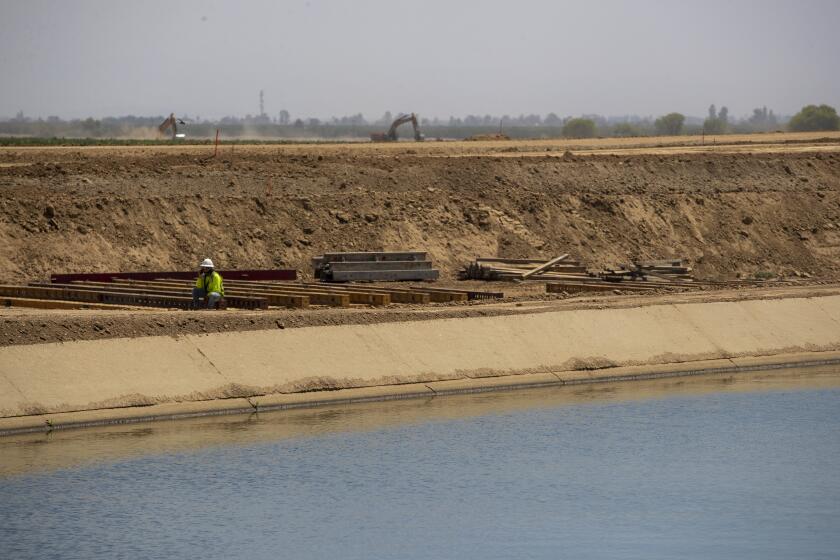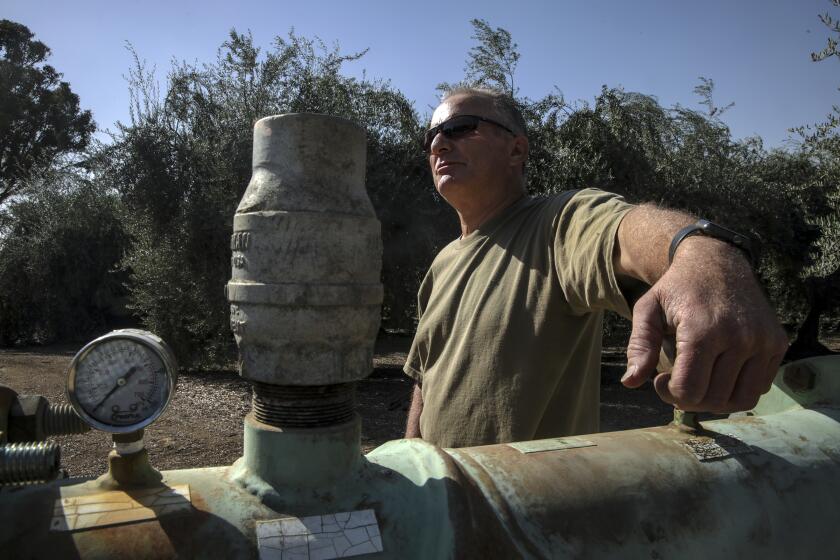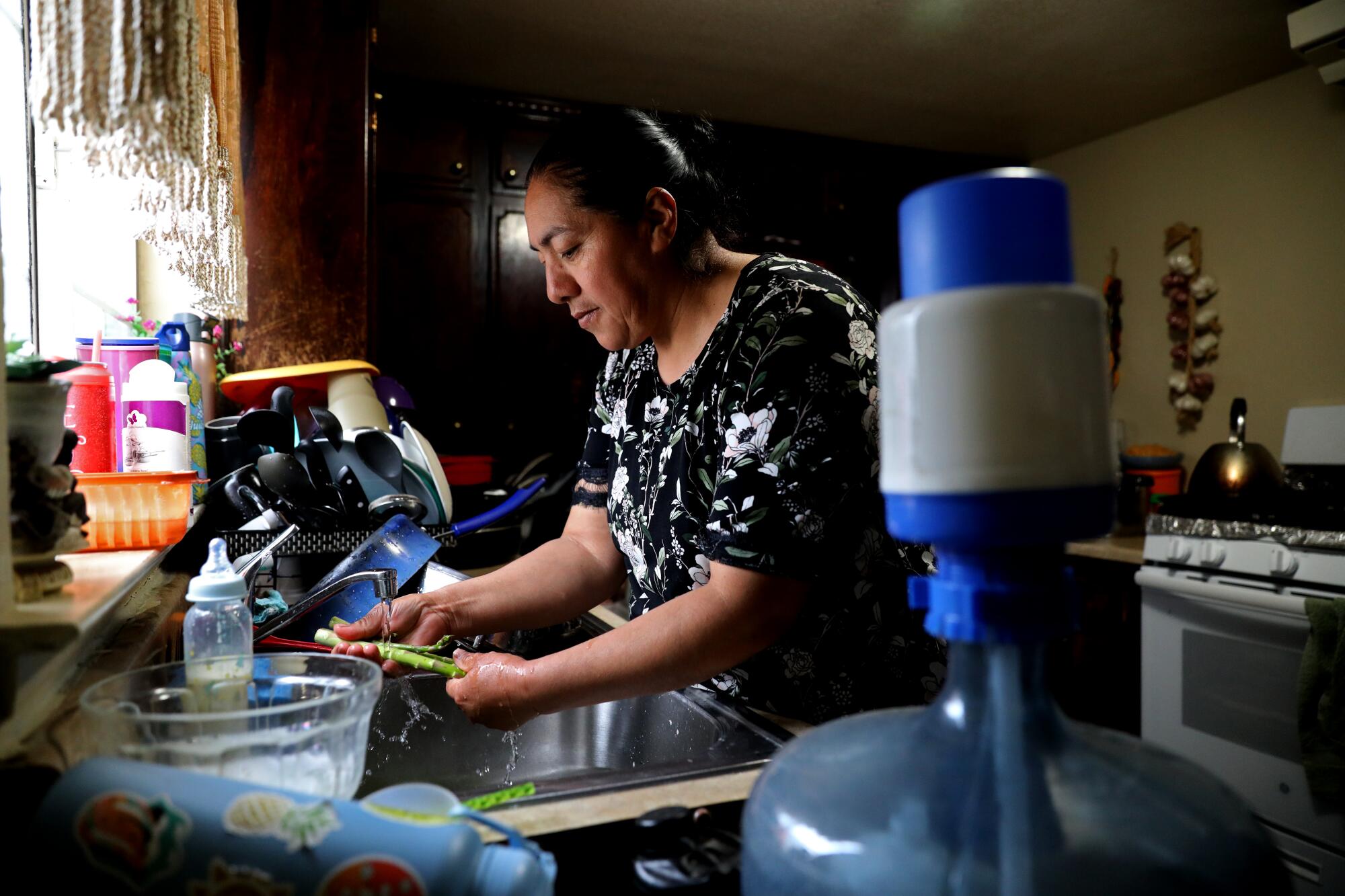
- Share via
SANGER, Calif. — In a neighborhood surrounded by almond orchards and citrus groves southeast of Fresno, large plastic cisterns occupy the yards of many homes, and residents have learned to ration water until the next tanker truck arrives.
Even after major storms have boosted California rivers and reservoirs, many in the unincorporated community of Tombstone Territory continue to rely on state-funded water deliveries. Some of their wells went dry last year, while others have been coping with dry wells for as long as three years.
“It is really a struggle,” said Anita Torres, 61. “Sometimes I just cry because I’m so frustrated.”
Since her well failed, she and her family have been taking short showers and lugging 5-gallon jugs into their home to cook and drink.
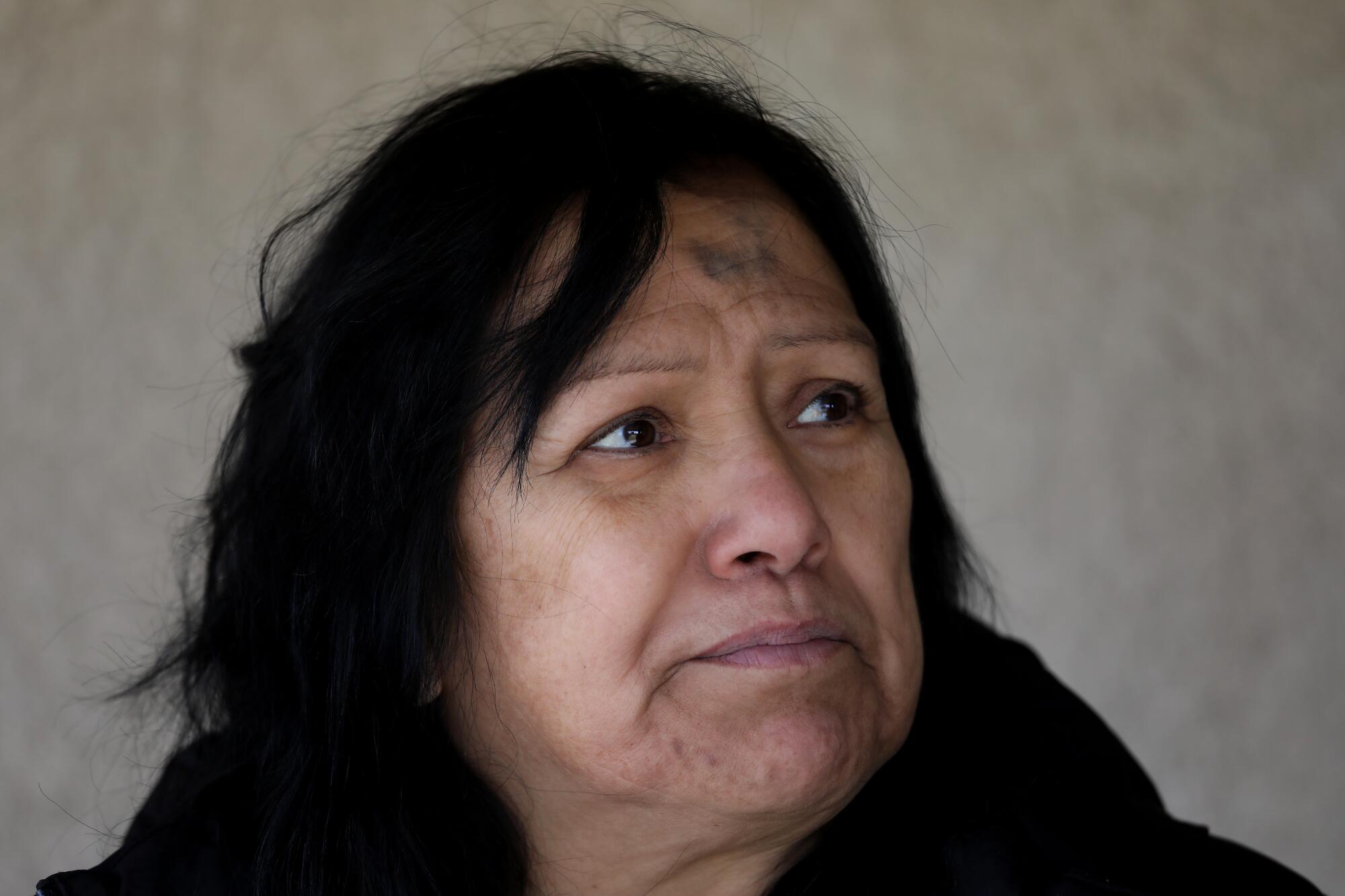
Tombstone is one of many communities in the San Joaquin Valley where chronic overpumping of groundwater by agriculture has left homeowners with dry wells.
Following three years of severe drought, the list of families who rely on state-funded water deliveries has grown dramatically. At the same time, the state has struggled to address a growing backlog of requests for new and deeper wells or for connections to water systems in neighboring cities.
The plight of residents in Tombstone and other communities has sparked heated criticism of the state government for not doing more to limit excessive pumping by large farms.
“We need to rein in the water abuse that’s happening right now and build the infrastructure that we need,” said Chirag Bhakta, California director of the advocacy group Food & Water Watch. “California likes to put itself out there, as a climate leader, as progressives on the climate issues and on global warming, but right in our backyard, right here in California, that’s not what our water situation actually shows.”
The group said in a recent report that the many dry wells in Tombstone Territory show the inequities in the state’s policies and point to a need for Gov. Gavin Newsom to curb agricultural pumping and prioritize water for residents. Bhakta and other activists have called for the Newsom administration to limit water use for such crops as almonds and pistachios, which corporate growers have planted across vast portions of the Central Valley over the past decade.
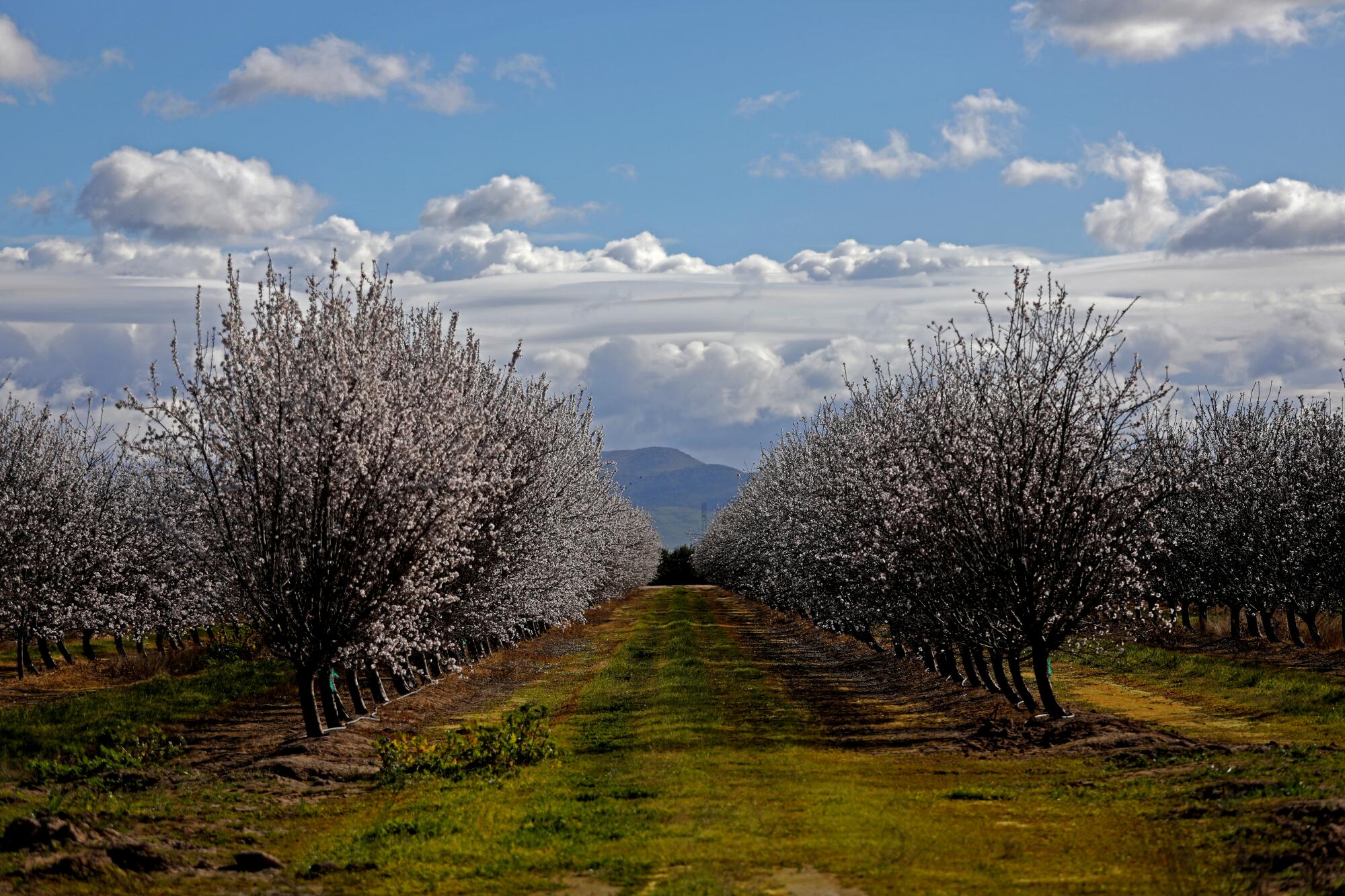
Groundwater depletion has progressively worsened through both wet and dry periods in the Central Valley, and accelerated over the last three years as heavy pumping sent aquifer levels plunging to new lows.
Scientists have estimated that groundwater losses since 1961 have totaled 93 million acre-feet — more than three times the capacity of Lake Mead, the nation’s largest reservoir.
“The gains made during wet years simply can’t offset the overpumping during the dry years in between,” Jay Famiglietti, a hydrologist and professor at Arizona State University, wrote recently. “In fact, the state’s groundwater deficit is now so large that it will never be fully replenished.”
Throughout the San Joaquin Valley, about 1,800 households are receiving water deliveries by truck, according to the organization Self-Help Enterprises, which runs the state-funded program. The largest numbers of dry household wells have been reported in Fresno County, where 518 homes now depend on water delivered by truck.
The increasing numbers of dry wells and homeowners waiting for solutions show that the effects of overpumping will persist for years to come, even as the state goes through wet times.
Tombstone resident Carolina Ledesma García, 48, recalls the day in 2019 when Newsom came to her neighborhood to announce legislation that was intended to help the approximately 1 million Californians who live with unsafe drinking water.
The governor met with residents to hear their concerns about wells going dry, and about nitrate contamination from fertilizers.
Newsom told them the new legislation would accelerate progress toward solutions in their community and others.
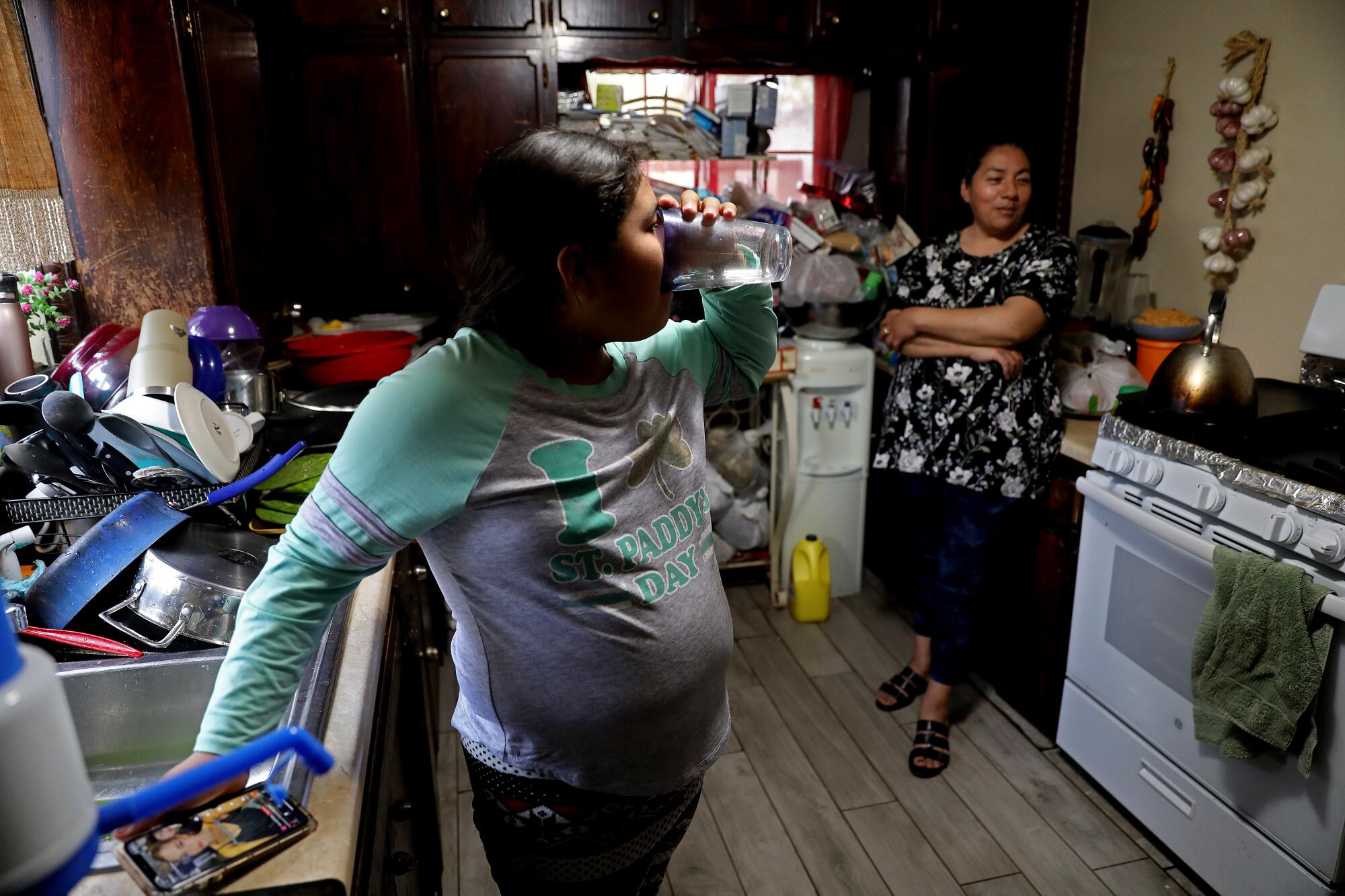
Ledesma, a former farmworker originally from Michoacán, Mexico, lives with her five children and her construction worker husband. They have been relying on weekly water deliveries since their well dried up about three years ago.
They are waiting for the state and the nearby city of Sanger to run a water pipe to their homes.
“The solution is for Sanger to help us,” Ledesma said.
The project has taken longer than expected, however.
Ledesma said she hopes the governor follows through and “he doesn’t fail us.”
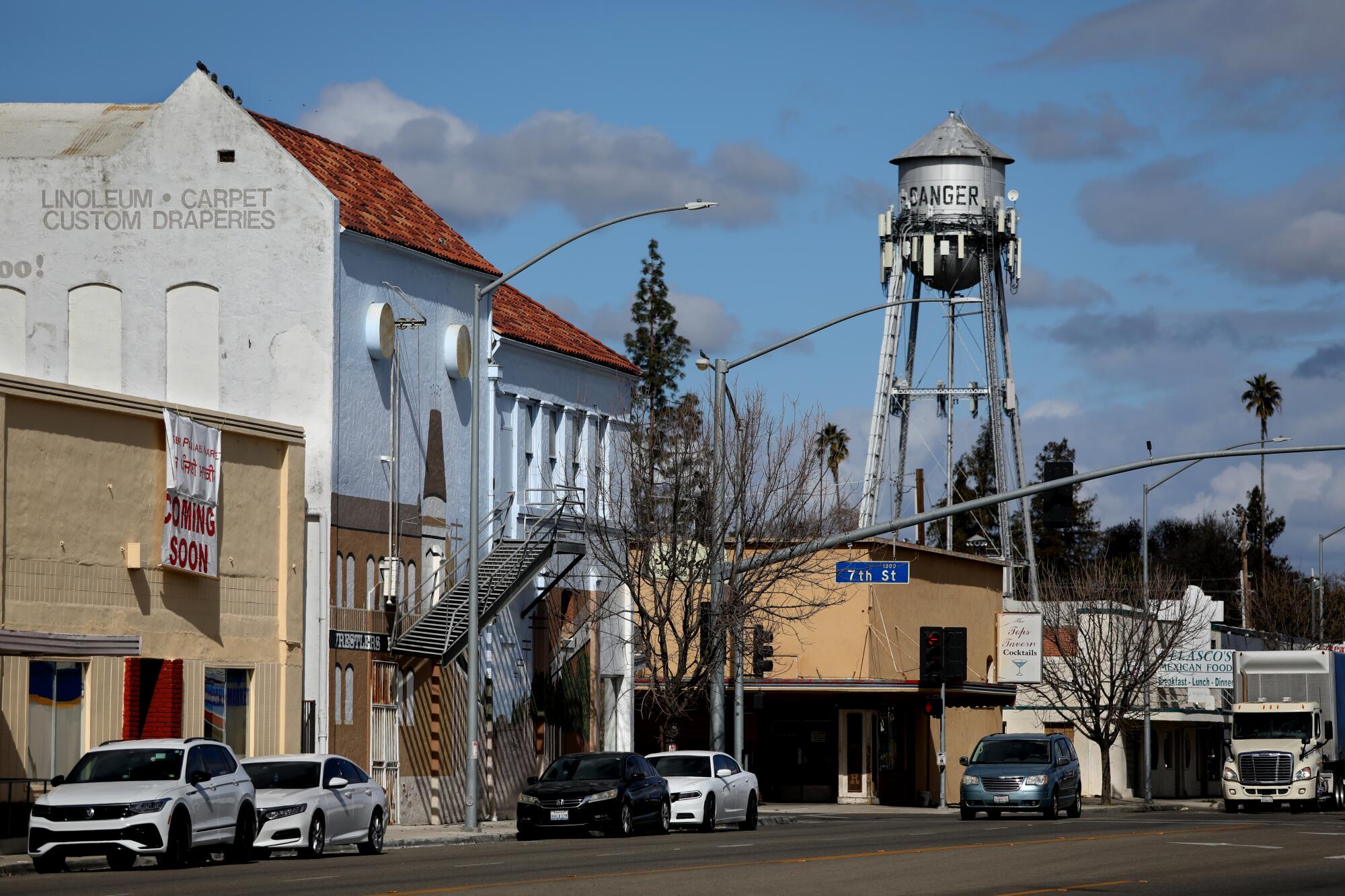
The state has provided Sanger nearly $6 million for projects that include running a water pipe in a one-mile loop to Tombstone, installing a new water tank and helping drill a new well. The water connection was originally slated to be finished by the end of 2022, but state officials said the project was delayed because some property owners didn’t want to allow access to build the pipeline and connections.
State officials said the city is looking at alternative paths for laying the pipe and will need to negotiate easements with landowners before moving ahead with construction.
“The state is committed to solving Tombstone’s drinking water problems,” said Alex Stack, a spokesperson for the governor’s office.
California regulators say groundwater plans are inadequate in six areas of the San Joaquin Valley. The move triggers state intervention to bolster regulation.
For now, 35 property owners have expressed interest in being connected to the water system, said Mariana Alvarenga, a policy advocate with the group Leadership Counsel for Justice and Accountability who has been working with the community.
Alex García, Ledesma’s 33-year-old nephew who lives across the street, said he hopes to be able to connect once the water line is built, but he’s starting to wonder whether that will happen.
“I honestly think they’re not going to help us out,” García said. “If they do, who knows when?”

The wait for water adds to the economic challenges faced by residents of a predominantly Latino community, particularly for those who work on farms, are retired or don’t have steady jobs.
Some live in homes their families built decades ago on land that was once a vineyard. They say the name Tombstone may come from the cemetery down the road, where gravestones dating to the late 1800s and early 1900s stand listing on uneven ground.
Homeowners regularly go outside to check how much water is left in their tanks, slapping and banging the plastic to gauge the water level.
Torres said when her family mistakenly used up the water in their tank, they had to shower at her granddaughter’s house until the next shipment arrived. To ration water, she has told her family they can’t take baths. She drives to the laundromat to wash their bedding.
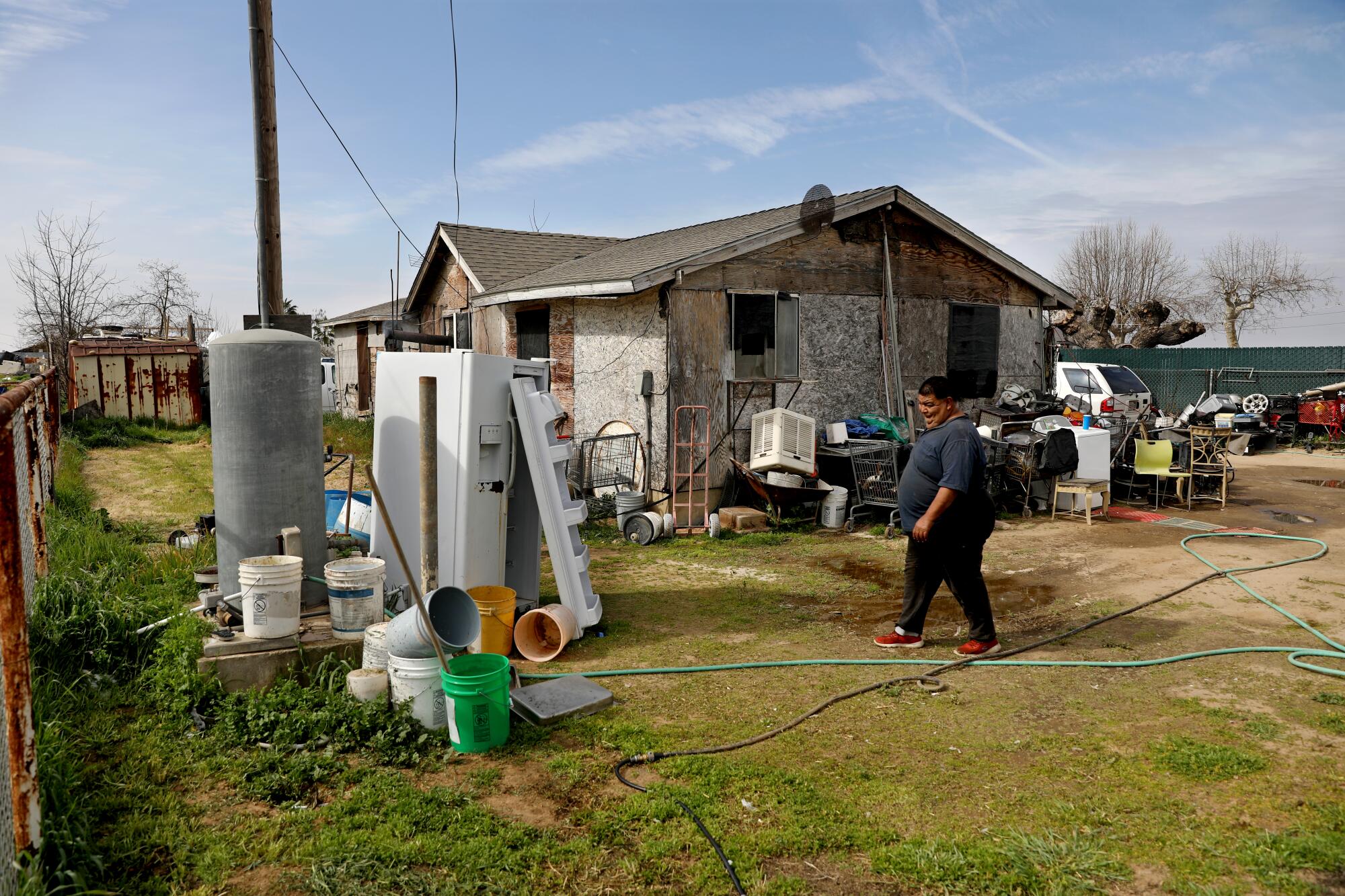
“I’m hoping they hurry up and connect to us,” Torres said. “We never thought it was going to be this long.”
Her husband, Michael Torres, a retired pipe manufacturing worker, said he feels angry that farmers have drilled more wells and planted more almonds in recent years. Around the neighborhood, almond orchards have recently bloomed with white blossoms.
“They’re sucking up all the water,” he said. “They should cut back.”
Neighbor Ray Cano, a 51-year-old mail carrier, agrees.
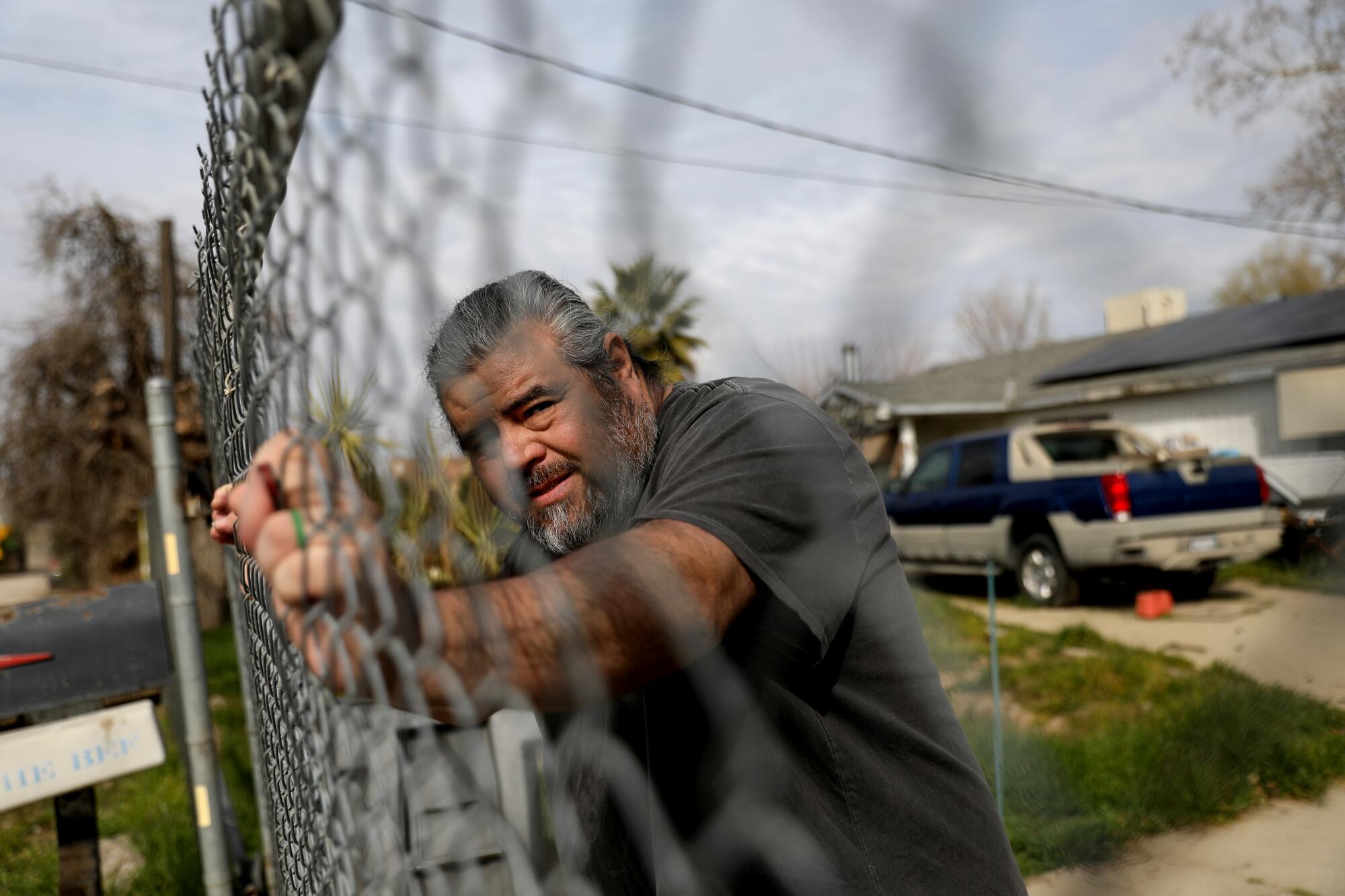
Cano has seen drilling rigs boring new wells on nearby farms, and he’s concerned those wells are deeper than the household wells.
“They shouldn’t be allowed to drill and pump water with impunity,” Cano said. “There should be restrictions placed on them, too.”
Local agencies are starting to implement plans for combating overpumping under the state’s 2014 Sustainable Groundwater Management Act, and state regulators have recently told local agencies in parts of the San Joaquin Valley that their plans are inadequate.
But Tombstone is in the Kings subbasin in Fresno County, where regulators have recommended approving local groundwater plans.
Well-drilling and pumping continue to draw down groundwater in California’s Central Valley. Calls are growing for stronger legislation and state intervention.
More than 1,400 dry household wells were reported throughout California last year, the highest number since the state started tracking reports of well failures in 2013.
So far this year, 140 dry wells have been reported to the state.
Tombstone is one of a number of Central Valley communities waiting to be linked to functioning water systems. To the south in Tulare County, state regulators have directed the city of Exeter to connect its water system to 77 homes in Tooleville, where the tap water is contaminated with cancer-causing hexavalent chromium and nitrate, and where the wells have been failing.
State officials say dozens of other consolidations have been completed under a program that provides funds to ensure clean and affordable drinking water, which the state declared a basic human right under legislation in 2012.
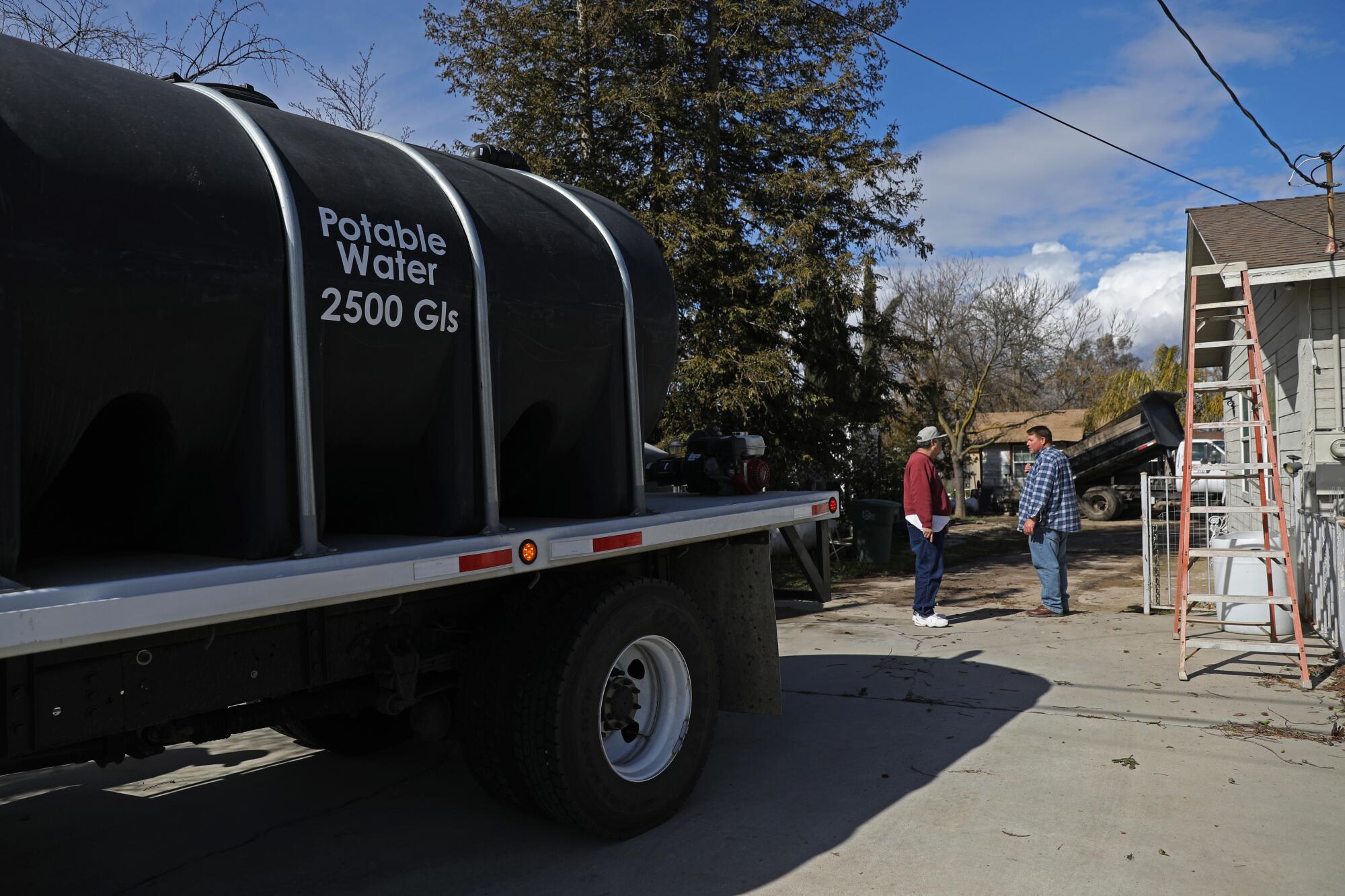
But many other rural homeowners with dry wells see the only solution as drilling a new well.
There are 204 low-income households that have state funding approved and are on a list to have new wells drilled, said Tami McVay, director of emergency services for Self‑Help Enterprises.
“They’re just waiting for the drillers to get permits and have a rig available to drill for them,” McVay said. She said an additional 365 households are going through the approval process.
The backlog stems from the big workload and the limited number of licensed well-drilling crews, McVay said.
Excessive groundwater pumping has long been depleting aquifers in California’s Central Valley. Now, scientists say the depletion is accelerating.
In recent months, household wells have been drying up faster than new wells have been drilled. But those managing the program say the pace of well-drilling has been accelerating. And state officials say they are taking steps to expedite funding for solutions.
“These problems have been around for a long time, and they’re going to take a while to address. But we’re definitely working as expeditiously as we can,” said Joe Karkoski, deputy director of the State Water Board’s financial assistance division.
The list of needed projects goes beyond wells that have dried up and includes water systems that draw from groundwater contaminated with nitrate, arsenic and other hazardous pollutants.
The State Water Resources Control Board says 389 public water systems are “failing,” 513 water systems are “at risk,” and an estimated 81,000 domestic wells are at risk of failing or having water-quality problems.
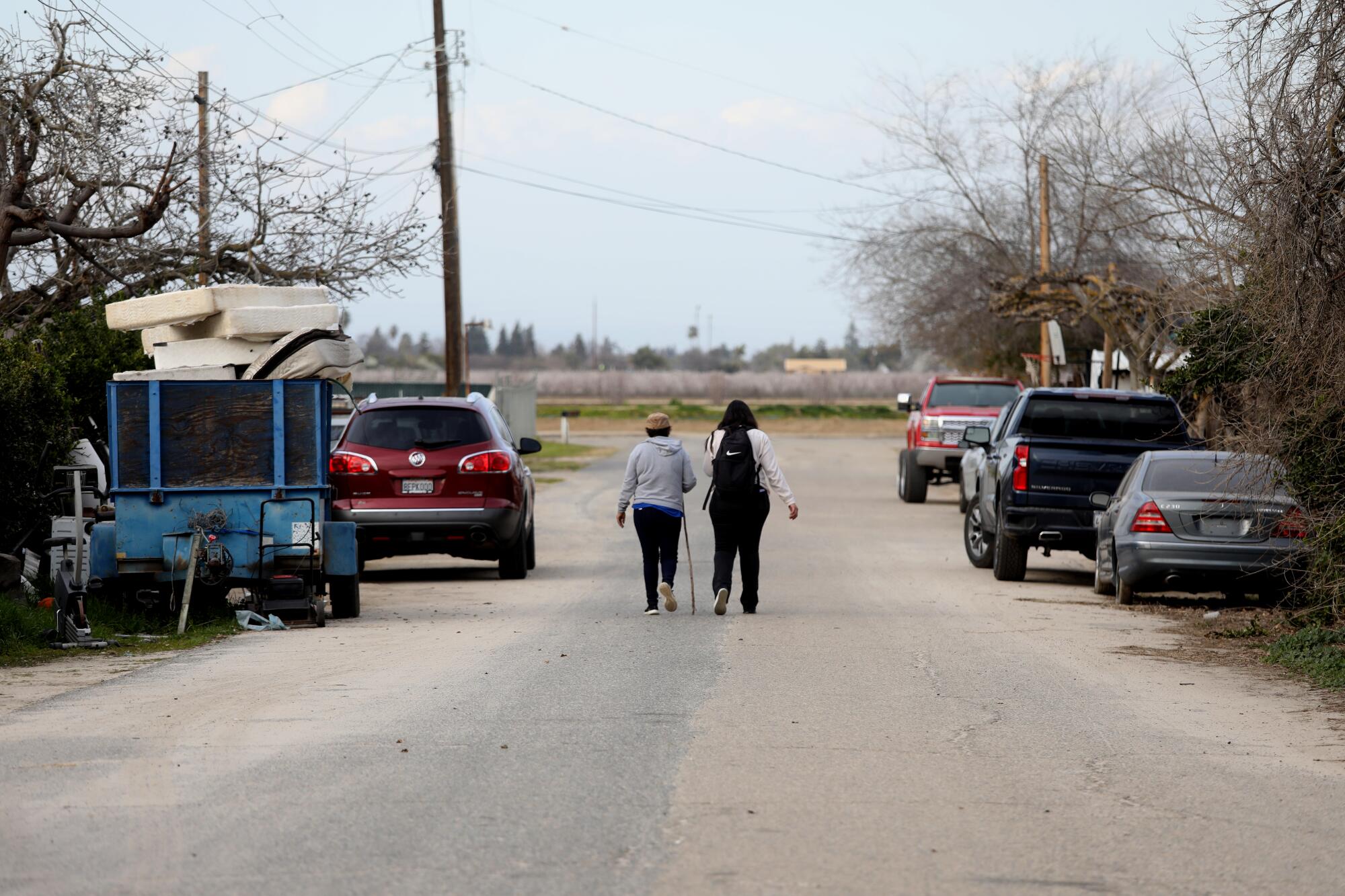
Some water advocates argue that solutions are coming far too slowly for people living with dry wells and that addressing the backlog would take many years at the current pace of well-drilling.
“The rate at which we’re getting wells replaced is just woefully inadequate,” said Kyle Jones, policy and legal director for the Community Water Center.
Jones said state officials should intervene to mobilize the well-drilling industry to prioritize residents with dry wells. As the situation stands, he said, drilling companies are responding to market demands by working on agricultural wells.
Jones suggested the state could put a moratorium on new agricultural wells until the backlog is addressed, or could hire well drillers on a retainer contract to fast-track projects for homeowners.
“We really need the governor to come in here and implement a solution,” Jones said.
